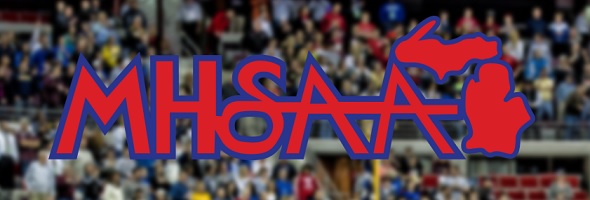
This Week in High School Sports: 10/16/15
October 16, 2015
The newest installment of This Week In High School Sports looks at the boys soccer and girls volleyball programs at Leland High School, hands out game balls to Tanner Christian of Caledonia High School and the boys and girls cross country teams at Lansing Catholic and finishes with a commentary on coach-official communication in basketball.
This Week In High School Sports will lead each show with feature stories from around the state from the MHSAA’s Second Half or from network affiliated stories and interviews. "Be The Referee," a 60-second look at the fine art of officiating, highlights the middle of the show and is followed by a closing "Perspective."
Listen to this week’s show by Clicking Here.
Past editions
Oct. 9: Kensington Lakes Activities Association football, local impacts of the MHSAA Football Playoffs - Listen
Oct. 2: High school teams giving back, parents' expectations for childen to go pro - Listen
Sept. 25: Otsego’s girls cross country team, MHSAA School Broadcast Program - Listen
Sept. 18: Constantine quarterback Matt Hasbrouck, day-to-day life for referees - Listen
Sept. 11: Mount Morris volleyball's Tabit twins, the truth about specialization - Listen
Sept. 4: Engadine/Brimley football, Good-bye to "a few good coaches" - Listen
Aug. 28: Ithaca football, MHSAA Health & Safety initiatives - Listen

NFHS Voice: Emphasis on Education
January 20, 2020
By Karissa Niehoff
NFHS Executive Director
Sometimes, numbers or statistics in sports can be misleading or perhaps even meaningless. Often, they simply do not tell the whole story.
Such was not the case, however, with the massive number of 10,000,000 announced last week by the NFHS. As in 10 million online education courses that have been taken by high school coaches, administrators, officials, students, parents, performing arts educators and others since the inception of the NFHS Learning Center in 2007.
When we talk about the difference between education-based sports within our nation’s high schools versus out-of-school club sports, this says it all. And the quest for more continues to rise each year.
After starting with 15,000 courses in 2007, more and more people have utilized the Learning Center (www.NFHSLearn.com) on computers, tablets and smartphones. The number of courses jumped to 200,000 by 2010 and 1,071,000 by 2015 and almost two million (1,975,000) last year.
While there are now more than 70 courses available through the NFHS Learning Center, including more than 35 that are offered at no cost, the runaway success story has been the free Concussion in Sports course that was launched in 2010 and updated in 2018.
With more than five million Concussion in Sports courses delivered in almost 10 years, the NFHS has been the leader in concussion recognition and management. This course teaches how to recognize a suspected concussion. It provides protocols to manage a suspected concussion. It provides steps to help players return to play safely after a concussion.
As a result of educational initiatives such as the Concussion in Sports course, and NFHS playing rules in all high school sports that contain guidelines for management of an athlete who exhibits signs and symptoms of a concussion, to the creation of concussion laws in every state, there are positive trends in concussion rates.
And that leads to some more meaningful numbers.
Data from the National High School Sports-Related Injury Surveillance Study released late last year indicated that concussion rates during football practices dropped from 5.47 to 4.44 concussions per 10,000 athletic exposures between the 2013-14 and 2017-18 seasons. Repeat concussion rates across all sports declined from 0.47 to 0.28 per 10,000 exposures during the same time period.
The annual increase in the number of individuals taking education courses on the Learning Center, which also includes the popular free courses Heat Illness Prevention and Sudden Cardiac Arrest, indicates – at least in part – the insatiable desire on the part of parents to determine the actual risk of playing contact sports.
And more and more when it comes to football – this country’s most popular contact sport – we believe the inherent risk has never been lower.
From the youth level where USA Football has created the Football Development Model to reduce contact and teach fundamentals in a progressive manner, to the educational initiatives of the NFHS to reduce injury risk in high school sports, the focus on player safety has never been higher.
And one more important number. We believe this continual rise in the number of people taking online education courses will have an additional benefit – a growing number of high school students competing in education-based sports and activity programs.
Dr. Karissa L. Niehoff is in her second year as executive director of the National Federation of State High School Associations (NFHS) in Indianapolis, Indiana. She is the first female to head the national leadership organization for high school athletics and performing arts activities and the sixth full-time executive director of the NFHS, which celebrated its 100th year of service during the 2018-19 school year. She previously was executive director of the Connecticut Association of Schools-Connecticut Interscholastic Athletic Conference for seven years.

